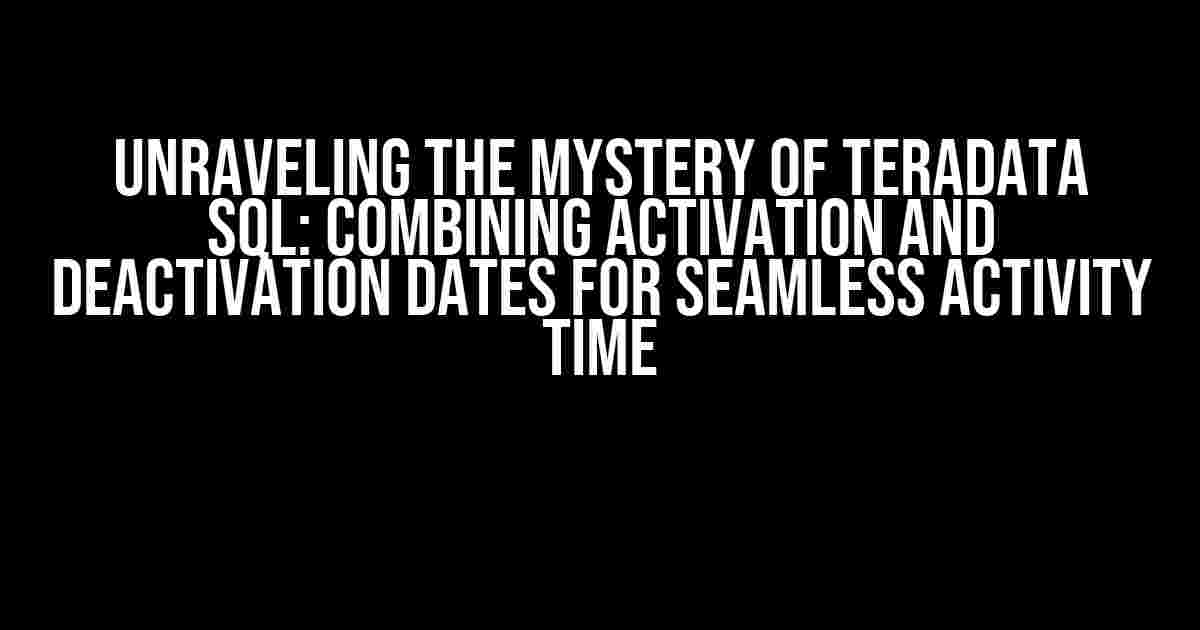Are you tired of sifting through rows and rows of individual activation and deactivation dates in your Teradata SQL table, only to struggle with combining them into a cohesive picture of activity time? You’re not alone! In this article, we’ll dive into the world of Teradata SQL and explore a step-by-step guide on how to merge those scattered dates into a single, easy-to-understand timeline. Buckle up, and let’s get started!
The Problem: A Table of Fragmented Dates
Imagine having a table with the following structure:
+---------+---------+------------+------------+ | ID | EVENT | DATE | TYPE | +---------+---------+------------+------------+ | 1 | ACT | 2022-01-01 | Activation | | 1 | DEACT | 2022-01-10 | Deactivation | | 2 | ACT | 2022-01-05 | Activation | | 2 | DEACT | 2022-01-12 | Deactivation | | 3 | ACT | 2022-01-03 | Activation | | 3 | DEACT | 2022-01-15 | Deactivation | +---------+---------+------------+------------+
In this table, each row represents an individual activation or deactivation event for a specific ID, with the corresponding date and type. But what if you want to see the full activity time for each ID, combining the activation and deactivation dates into a single, continuous range?
The Solution: Using Teradata SQL to Combine Dates
Fortunately, Teradata SQL provides a robust set of functions to tackle this challenge. We’ll use a combination of aggregation, conditional logic, and date manipulation to merge the activation and deactivation dates into a single activity period.
Step 1: Prepare the Data
First, let’s create a working table with the necessary data:
CREATE VOLATILE TABLE working_table AS (
SELECT ID,
EVENT,
DATE,
TYPE
FROM your_table
WHERE TYPE IN ('Activation', 'Deactivation')
) WITH DATA;
This creates a volatile table with only the activation and deactivation events, making it easier to work with.
Step 2: Find the Earliest Activation and Latest Deactivation Dates
Next, we’ll find the earliest activation and latest deactivation dates for each ID using the `MIN` and `MAX` aggregation functions:
CREATE VOLATILE TABLE activity_dates AS (
SELECT ID,
MIN(CASE WHEN TYPE = 'Activation' THEN DATE ELSE NULL END) AS activation_date,
MAX(CASE WHEN TYPE = 'Deactivation' THEN DATE ELSE NULL END) AS deactivation_date
FROM working_table
GROUP BY ID
) WITH DATA;
This creates a new table with the earliest activation and latest deactivation dates for each ID.
Step 3: Calculate the Activity Time
Now, we’ll calculate the activity time for each ID by subtracting the activation date from the deactivation date. We’ll also handle cases where there’s no deactivation date (e.g., the ID is still active):
CREATE VOLATILE TABLE activity_time AS (
SELECT ID,
COALESCE(deactivation_date, CURRENT_DATE) - activation_date AS activity_time
FROM activity_dates
) WITH DATA;
This creates a new table with the calculated activity time for each ID.
Step 4: Present the Results
Finally, let’s present the results in a clear and concise format:
SELECT ID,
activity_time
FROM activity_time
ORDER BY ID;
This will give you a list of IDs with their corresponding activity times.
Example Output
Here’s what the final output might look like:
| ID | Activity Time |
|---|---|
| 1 | 9 days |
| 2 | 7 days |
| 3 | 12 days |
In this example, ID 1 was active for 9 days, ID 2 was active for 7 days, and ID 3 was active for 12 days.
Conclusion
By following these steps, you’ve successfully combined the activation and deactivation dates in your Teradata SQL table to showcase the full activity time for each ID. This technique can be applied to various scenarios where you need to merge fragmented dates into a cohesive timeline.
Remember, with Teradata SQL, the power to manipulate and analyze complex data is at your fingertips. Don’t be afraid to experiment and push the boundaries of what’s possible!
Happy querying!
Frequently Asked Question
Are you struggling to combine activation and deactivation activity dates in a Teradata SQL table? We’ve got you covered!
How do I combine multiple rows of activation and deactivation dates into a single row with a start and end date?
You can use the LEAD and LAG functions in Teradata SQL to achieve this. The LEAD function allows you to access data from a subsequent row within the same result set, while the LAG function accesses data from a previous row. You can use these functions to create a new table with a single row per activity period, with the start date being the activation date and the end date being the deactivation date.
What if I have multiple overlapping activity periods for the same item, how do I handle those?
To handle overlapping activity periods, you can use a combination of the ROW_NUMBER and CASE functions. First, use ROW_NUMBER to assign a unique identifier to each row. Then, use CASE to identify the start and end dates for each activity period, based on the activation and deactivation dates. Finally, use the LEAD and LAG functions to combine the overlapping periods.
Can I use a single query to combine the activation and deactivation dates, without creating a new table?
Yes, you can use a single query with a Common Table Expression (CTE) to combine the activation and deactivation dates without creating a new table. The CTE allows you to define a temporary result set that can be referenced within the main query. This approach can make the query more efficient and easier to maintain.
How do I handle gaps in the activity periods, where an item is deactivated and then reactivated at a later date?
To handle gaps in the activity periods, you can use the-islands-and-gaps approach. This involves identifying the distinct activity periods using the LEAD and LAG functions, and then using the ROW_NUMBER function to assign a unique identifier to each period. Finally, you can use the MIN and MAX functions to calculate the start and end dates for each period.
Are there any performance considerations I should keep in mind when combining activation and deactivation dates in a large Teradata SQL table?
Yes, when working with large tables, performance can be a concern. To optimize performance, consider using efficient indexing strategies, such as indexing the activation and deactivation date columns. Additionally, use efficient join and aggregation techniques, and avoid using correlated subqueries or self-joins. Finally, consider using Teradata’s built-in optimization features, such as query rewriting and caching.


